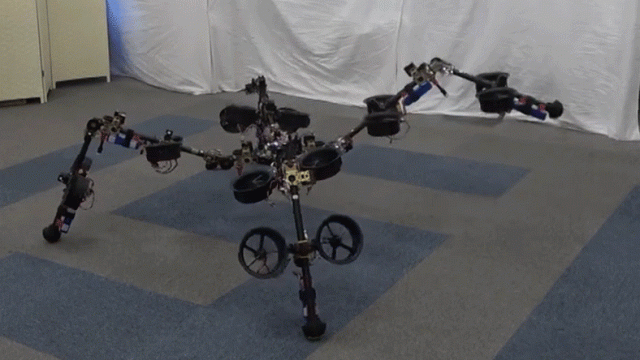You can stop stressing out about UFOs now, because researchers from The University of Tokyo have decided we need a more terrifying concern to keep us up all night: robot spiders that can both crawl and fly.
Real spiders have already figured out how to fly, which they do by spinning ultralight silk parachutes (some 3.05 m long) and floating on the wind. It allows them to cross large distances much faster than even walking on eight legs can, and also makes it easier for them to traverse difficult terrain. But replicating that multimodal approach on a robot? That quickly becomes a battle between size, weight, and gravity. Most flying spiders are just millimetres long.
Instead, making a flying spider involves equipping it with more active equipment. The problem is that just packing a multi-legged robot with enough servo motors and batteries to crawl around on its individual limb segments is already a massive undertaking. Boston Dynamics’ SPOT, an impressively agile robot dog, weighs in at almost 32 kg in its lightest configuration. Adding enough motors and thrusters on top of that to then let it fly will result in an even heavier robot that comes with lots of practicality compromises, including how long it can actually operate before needing a charge.
The key to how the University of Tokyo’s new robot spider flies, and even walks, is actually in its name. Meet SPIDAR, and brace yourselves for this acronym. The “SPherIcally vectorable and Distributed rotors assisted Air-ground amphibious quadruped Robot” uses lightweight, but relatively weak, servos on its articulated limbs that aren’t actually strong enough for the 15 kg bot to stand on its own. This keeps it light enough to achieve lift without a jet engine, but it does mean that the spider needs to keep a constant bounce going just to stay upright.
SPIDAR’s leg movements are powered by 16 manoeuvrable thrusters, four on each leg, that can be used to rotate, move, and position the robot’s eight leg segments. When all of the thrusters and leg movements are properly coordinated, SPIDAR can stand up and walk, although it currently moves very slowly and very loudly. When they’re all pointed downwards, those 16 thrusters also produce enough lift to make SPIDAR fly, and it can soar for a total of nine minutes before depleting its batteries, or walk for up to 18. That’s not quite enough runtime to be useful for anything practical just yet, but as the video demonstrates, SPIDAR is very much an unrefined prototype at this point.
It’s an interesting approach to making multimodal locomotion work on a robot, but is this really the path that robots are going to take? Watching the flightless SPOT navigate our world seems to indicate SPIDAR doesn’t actually have a leg to stand on. But as a way to improve the capabilities of drones? Including where they can safely come in for a landing? There’s definitely some potential there.
